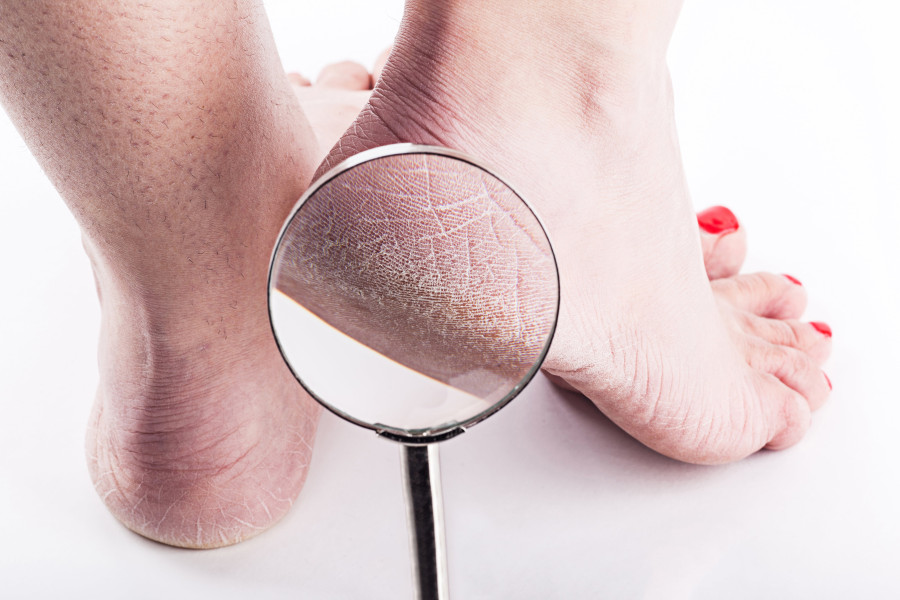Life & Style
Caring for cracked feet
Consultant Dermatologist Prarthana Adhikari discusses the causes and cures of heel fissures.
Anish Ghimire
In winter, we focus on keeping our faces and hands moisturised, often neglecting our feet. This is why many suffer from cracked feet, known as heel fissures, during the colder months.
Getting soft, supple soles begins with understanding the causes of heel fissures and adopting a few simple habits. Dr Prarthana Adhikari, a consultant dermatologist at DI Skin Hospital and Referral Centre (DISHARC), discusses the causes, symptoms and treatment of the condition.
Adhikari completed her post-graduation from Tonji Medical College, China, on a scholarship granted by the Chinese government. She completed her observership in Clinical Dermatology at Mount Sinai Hospital in New York, USA.
What are heel fissures?
Heel fissures, also known as cracked heels, are a disorder that causes dry, rough and cracked skin on the heels. This condition occurs when the skin on the heel loses moisture, resulting in a dry and hard texture. The basic symptoms of heel fissures include dry skin, where natural moisture levels are considerably reduced, resulting in a painful and rigid sole. The condition causes pain and suffering by causing cracks to grow, which can range from superficial to deep.
In severe situations, these cracks may cause bleeding, adding another layer of complexity to the agony felt by people suffering from heel fissures. Additionally, the presence of calluses is a notable symptom, further highlighting the impact of this condition on the skin's health.
What causes heel fissures?
Heel fissures can stem from various causes and are influenced by specific risk factors. The primary causes include dry skin, which can result from inadequate moisturisation, barefoot walking that exposes the heels to friction and pressure, and inactive sweat glands that contribute to reduced moisture levels. Regularly wearing open and flat shoes, especially in dry climates, can exacerbate the condition, as can excessive weight, which puts added pressure on the feet.
Several risk factors also contribute to the development of heel fissures. Medical conditions such as diabetes, hypothyroidism, and rheumatoid arthritis increase the likelihood of experiencing this condition. Skin disorders like psoriasis, dermatitis, and scleroderma can also elevate the risk of developing heel fissures. It's important to be aware of these causes and risk factors, as addressing them can play a significant role in both preventing and managing heel fissures effectively.
Lifestyle factors such as diet and hydration play a significant role in impacting the skin health of individuals with cracked heels. Including supplements rich in vitamins C, B-3, B-7, and E, such as wheat germ oil, hazelnut, sunflower, and almond oil, can contribute to skin health and aid in the healing of cracked heels.
Hydration is crucial, and drinking plenty of water is essential to keep the skin healthy, hydrated, and moisturised. Adequate water intake helps maintain skin elasticity and supports overall skin health.
What should one do to cure heel fissures?
Individuals suffering from heel fissures must follow a healthy skincare regimen. Begin by moisturising the affected regions on a daily basis using a heavy oil-based cream or petroleum jelly to keep the skin moisturised and healing. When cleaning the feet, use a gentle cleaner rather than strong soaps, and avoid scrubbing excessively, as this can contribute to dryness.
To avoid further dryness, avoid soaking the feet in hot water and instead opt for lukewarm water. When it comes to footwear, choose closed shoes with superior soles to prevent friction and relieve pressure on the heels. To reduce stress, avoid walking barefoot on rough surfaces and consider utilising protective heel cups. To encourage smoother skin, use gentle exfoliating chemicals in your routine and choose breathable cotton socks for comfort and moisture control.
How does one treat heel fissures?
The typical treatment for heel fissures involves using heavy oil-based moisturising creams and ointments containing petroleum jelly to address dryness. Moisturisers with ceramides and natural oils strengthen the skin's barrier, while those with 10-15% urea content effectively retain moisture. Additionally, exfoliation with alpha hydroxy acids like salicylic acid helps remove dead skin cells and improve overall skin texture. Consistent application of these treatments is crucial for healing and preventing further complications.
Are there different types or stages of heel fissures?
Yes, heel fissures can be categorised into different types or stages based on their symptoms, distinguishing between mild and severe forms. The mild form is characterised by symptoms such as yellowish discoloured skin, noticeable thickening around the cracks, and visible splitting on the heels. In this stage, the condition may cause discomfort, but the symptoms are generally less severe.
On the other hand, the severe form of heel fissures presents more intense symptoms. This includes bleeding from the cracks, the presence of open wounds, and pain experienced during walking and when pressure is applied to the heels. In severe cases, deep ulcers may develop, posing a risk of infection and potentially leading to cellulitis. It's crucial to differentiate between these stages as the severity of symptoms guides the appropriate course of treatment and care needed to address heel fissures effectively. Early intervention is key to preventing the progression of the condition to more severe stages.




 5.14°C Kathmandu
5.14°C Kathmandu










